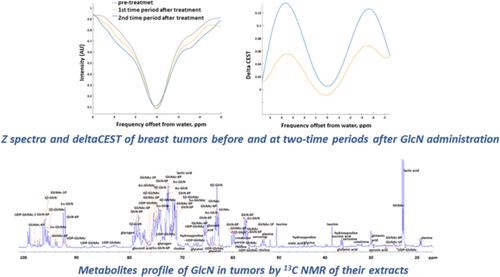当前位置:
X-MOL 学术
›
NMR Biomed.
›
论文详情
Our official English website, www.x-mol.net, welcomes your
feedback! (Note: you will need to create a separate account there.)
Molecular imaging of cancer by glucosamine chemical exchange saturation transfer MRI: A preclinical study
NMR in Biomedicine ( IF 2.7 ) Pub Date : 2020-10-26 , DOI: 10.1002/nbm.4431 Michal Rivlin 1 , Gil Navon 1
NMR in Biomedicine ( IF 2.7 ) Pub Date : 2020-10-26 , DOI: 10.1002/nbm.4431 Michal Rivlin 1 , Gil Navon 1
Affiliation

|
Glucosamine (GlcN) was recently proposed as an agent with an excellent safety profile to detect cancer with the chemical exchange saturation transfer (CEST) MRI technique. Translation of the GlcN CEST method to the clinical application requires evaluation of its sensitivity to the different frequency regions of irradiation. Hence, imaging of the GlcN signal was established for the full Z spectra recorded following GlcN administration to mice bearing implanted 4T1 breast tumors. Significant CEST effects were observed at around 1.5, 3.6 and −3.4 ppm, corresponding to the hydroxyl, amine/amide exchangeable protons and for the Nuclear Overhauser Enhancement (NOE), respectively. The sources of the observed CEST effects were investigated by identifying the GlcN metabolic products as observed by 13C NMR spectroscopy studies of extracts from the same tumor model following treatment with [UL‐13C] ‐GlcN·HCl. The CEST contribution can be attributed to several phosphorylated products of GlcN, including uridine diphosphate‐N‐acetylglucosamine (UDP‐GlcNAc), which is a substrate for the O‐linked and N‐linked glycosylated proteins that may be associated with the increase of the NOE signal. The observation of a significant amount of lactate among the metabolic products hints at acidification as one of the sources of the enhanced CEST effect of GlcN. The proposed method may offer a new approach for clinical molecular imaging that enables the detection of metabolically active tumors and may play a role in other diseases.
中文翻译:

通过氨基葡萄糖化学交换饱和转移 MRI 对癌症进行分子成像:一项临床前研究
氨基葡萄糖 (GlcN) 最近被提议作为一种具有出色安全性的试剂,可通过化学交换饱和转移 (CEST) MRI 技术检测癌症。将 GlcN CEST 方法转化为临床应用需要评估其对不同辐射频率区域的敏感性。因此,GlcN 信号的成像是针对在将 GlcN 施用于植入了 4T1 乳腺肿瘤的小鼠后记录的完整 Z 光谱建立的。在大约 1.5、3.6 和 -3.4 ppm 处观察到显着的 CEST 效应,分别对应于羟基、胺/酰胺可交换质子和核 Overhauser 增强 (NOE)。通过鉴定13观察到的 GlcN 代谢产物来研究观察到的 CEST 效应的来源用 [UL- 13 C] -GlcN·HCl处理来自同一肿瘤模型的提取物的 C NMR 光谱研究。CEST 的贡献可归因于 GlcN 的几种磷酸化产物,包括尿苷二磷酸-N-乙酰氨基葡萄糖(UDP-GlcNAc),它是 O-连接和 N-连接糖基化蛋白的底物,可能与NOE 信号。在代谢产物中观察到大量乳酸表明酸化是 GlcN 增强 CEST 效应的来源之一。所提出的方法可能为临床分子成像提供一种新方法,该方法能够检测代谢活跃的肿瘤,并可能在其他疾病中发挥作用。
更新日期:2021-01-04
中文翻译:

通过氨基葡萄糖化学交换饱和转移 MRI 对癌症进行分子成像:一项临床前研究
氨基葡萄糖 (GlcN) 最近被提议作为一种具有出色安全性的试剂,可通过化学交换饱和转移 (CEST) MRI 技术检测癌症。将 GlcN CEST 方法转化为临床应用需要评估其对不同辐射频率区域的敏感性。因此,GlcN 信号的成像是针对在将 GlcN 施用于植入了 4T1 乳腺肿瘤的小鼠后记录的完整 Z 光谱建立的。在大约 1.5、3.6 和 -3.4 ppm 处观察到显着的 CEST 效应,分别对应于羟基、胺/酰胺可交换质子和核 Overhauser 增强 (NOE)。通过鉴定13观察到的 GlcN 代谢产物来研究观察到的 CEST 效应的来源用 [UL- 13 C] -GlcN·HCl处理来自同一肿瘤模型的提取物的 C NMR 光谱研究。CEST 的贡献可归因于 GlcN 的几种磷酸化产物,包括尿苷二磷酸-N-乙酰氨基葡萄糖(UDP-GlcNAc),它是 O-连接和 N-连接糖基化蛋白的底物,可能与NOE 信号。在代谢产物中观察到大量乳酸表明酸化是 GlcN 增强 CEST 效应的来源之一。所提出的方法可能为临床分子成像提供一种新方法,该方法能够检测代谢活跃的肿瘤,并可能在其他疾病中发挥作用。











































 京公网安备 11010802027423号
京公网安备 11010802027423号